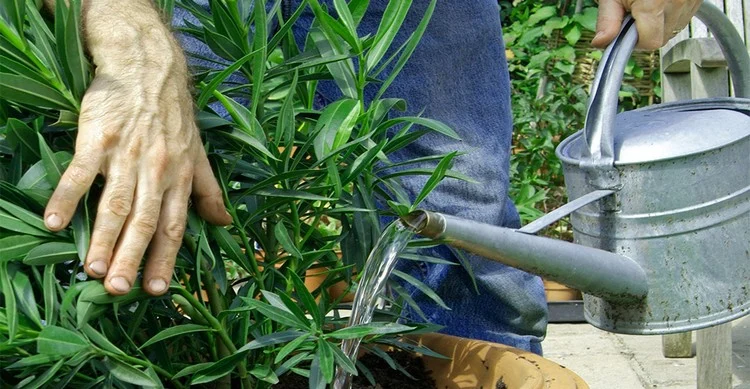Although the oleander is considered drought tolerant, it should be properly watered during the hot summer months. But when and how often should you water the oleander and what problems can arise? Can it also benefit from rainwater?
If you are looking for a hardy shrub that will provide plenty of blooms from spring through fall, then the oleander is an extremely popular choice. An ornamental evergreen shrub with large flowers, it is a characteristic plant of the Mediterranean region. And although it has no special watering requirements and is quite resistant to water shortages, it should still be watered regularly in the summer. Find out when and how often you should water your oleander so that it blooms profusely and for a long time.
Watering oleanders: tips for proper watering
The oleander is usually grown in pots and is placed outside in the summer to decorate the garden with its blooms. One of its advantages is that it is fairly easy to care for. Its water requirement is low, although it should be watered regularly in the hot months to promote flowering. Learn how to properly water your oleander to keep it blooming all summer long.
When and how often should the oleander be watered?
The ideal time to water the oleander is early in the morning when it’s not too warm. Then evaporation is low and the plant has time to absorb the water.
The frequency of watering should be adjusted according to the season.
In spring and autumn, the oleander should only be watered when the soil is completely dry.
In summer, during the growing season and flowering, when temperatures rise and the plant needs more water, it should be watered once in the morning and once in the evening.
During the winter months, watering should be reduced and you should try to minimize humidity. If the oleander is placed in a cool room, watering it every two to three weeks is enough.
Oleanders water directly on the ground
One of the ways to water your oleander is to give the soil plenty of water.
In order to create a balance between moisture and dryness for the plant, it is advisable to let the soil dry out first.
Since it usually dries from top to bottom, you should use a long, thin wooden stick to check it. The wooden stick should easily penetrate the soil surface and reach the top 5 cm. Pull it out and when it feels dry it’s time to water your oleander.
Water the soil thoroughly with a long-spout watering can and allow the plant to sit for a minute before discarding the excess water from the saucer. Never leave the plant in the water for too long and make sure that the leaves and flowers do not get wet when watering to avoid fungal diseases.
Pour into the saucer
Fill the coaster with water, making sure the soil comes into contact with the water. Let the plant sit for 10 minutes and discard the excess water from the saucer once the soil is evenly moist. If the soil still looks dry, pour more water into the saucer and let the oleander sit for another 20 minutes. Carefully remove the remaining water.
If the summer is very dry and there is no rainfall, you should water the plant from above at least once a week. The remaining water can be added directly to the saucer.
Can you save a dried up oleander?
The oleander in the pot can dry out very quickly in summer due to a lack of water and shed its leaves. In this case you should not take the oleander out of the pot, even if it has lost all its leaves and looks completely dried up.
Water the plant sufficiently and frequently and there is a good chance that it will produce new foliage within the next 10 days. It will grow very slowly at first, but it will recover after a few months.
What to do in case of overwatering?
The most common symptoms of overwatering are yellow leaves, root rot, and leaf drop. If you find that you have watered your plant too much, you should take the following measures.
Increase soil aeration by regularly fluffing the surface. Allow the soil to dry out completely before watering the oleander again. Provide a well-ventilated, warm environment to promote water evaporation.
Can you water the oleander with rainwater?
Although many plants only benefit from rainwater, avoid watering your oleander with it. The plant does not tolerate rainwater as it makes the soil in the tub acidic. Oleanders thrive best in calcareous soil and therefore require calcareous tap water.
